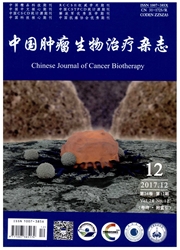

 中文摘要:
中文摘要:
目的:探讨聚酰胺-胺型(polyamidoamine,PAMAM)树枝状高聚合物介导survivin反义寡核苷酸(survivin antisense oligodeoxynucleotide,survivin-asODN)对肝癌裸鼠移植瘤及其微血管形成的抑制作用。方法:以人肝癌细胞SMMC-7721裸鼠皮下注射建立肝癌裸鼠皮下移植瘤模型。将PAMAM和阳离子脂质体分别与survivin-asODN混合得到载反义基因复合物,透射电镜观察复合物的形态、粒径,zeta电位分析仪测定复合物的zeta电位,离心法和紫外分光分度仪测定复合物的的包封率和体外DNA释放速度。将两种反义基因复合物分别注射裸鼠移植瘤体内,观察两组移植瘤大小;免疫组化方法检测瘤组织中微血管密度(microvessel density,MVD);Western blotting检测移植瘤组织中survivin蛋白的表达。结果:PAMAM-survivin-asODN复合物的粒径小于脂质体.survivin-asODN复合物的粒径[(64.94±9.6)vs(193.94±32.2)am,P〈0.01],而zeta电位高于脂质体.survivin-asODN复合物[(37.74±3.8)vs(22.64±2.2)mV,P〈0.05];基因包封率两组比较无显著差异;PAMAM反义基因复合物对DNA持续释放达14d,但脂质体复合物只持续5d。PAMAM-survivin-asODN复合物治疗组裸鼠移植瘤组织survivin蛋白表达低于脂质体-survivin-asODN复合物组[(26.84±5.6)vs(37.04±5.9),P〈0.05];PAMAM-survivin-asODN复合物治疗组移植瘤重量低于脂质体-survivin-asODN复合物组[(124.84±25.2)vs(210.24±33.6)mg,P〈0.05],其微血管密度低于脂质体-survivin-asODN复合物组[(2.84±1.5)vs(6.44±2.7),P〈0.05]。结论:PAMAM能将survivin-asODN高效递送到肝癌移植瘤细胞,降低瘤组织中survivin蛋白的表达,可通过抑制移植瘤微血管的形成来抑制癌细胞的生长。
 英文摘要:
英文摘要:
Objective: To evaluate the anti-tumor and anti-angiogenesis effects of survivin antisense oligodeoxynucleotide (survivin-asODN) carried by polyamidoamine (PAMAM) dendrimer on subcutaneously-transplanted hepatic cancer in nude mice. Methods: Hepatic cancer model was established by injecting hepatic cancer SMMC-7721 cells into the flanks of nude mice subcutaneously. Survivin-asODN was mixed with the polyamidoamine dendrimer or liposome to obtain the antisense oligodeoxynucleotide complexes. The shape and size of the complexes were observed by transmission electron microscope and the zeta potential was measured by analytical tool. The encapsulating efficiency and the in vitro DNA release rate were determined by centrifugation and ultraviolet spectrophotometer, respectively. When the transplanted tumors were palpable, the 2 kinds of complexes were directly injected into the xenografts ; the size of tumors was observed ; the micro-vessel density was measured by immunohistochemistry method; The expression of survivin protein in the trans- plant tumor was examined by Western blotting. Results: The diameter of PAMAM-survivi-asODN complex was shorter than that of liposome-survivin-asODN complex( [64.9±9.6] vs [ 193.9±32.2] nm,P 〈0.01 ) ; the zeta potential was higher than that of liposome-survivin-asODN complex ( [ 37.7±3.8 ] vs [ 22.6±2.2 ] mV, P 〈 0.05 ) ; there was no significant difference in the envelopment rates between PAMAM group and liposome group; The in vitro release of survivin DNA lasted 14 d in the PAMAM group and 5 d in the liposome group. The expression of survivin protein in PAMAM group was less than that in the liposome group ( [ 26.8±5.6 ] vs [ 37.0±5.9 ], P 〈 0.05 ) ; The tumor weight ( [ 124.8± 25. 2 ] vs [ 210.2±33.6 ] mg,P 〈 0.05 ) and the microvessel density ( [ 2.8±1.5 ] vs [ 6.4± 2.7 ], P 〈 0.05 ) in the PAM- AM group were lower than those in the liposome group. Conclusion: The polyamidoamine dendrimer can effectively deliver survivin-asODN
 同期刊论文项目
同期刊论文项目
 同项目期刊论文
同项目期刊论文
 期刊信息
期刊信息
